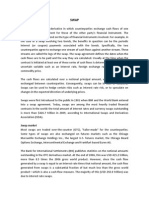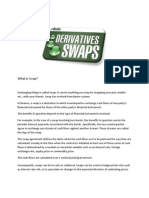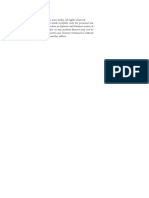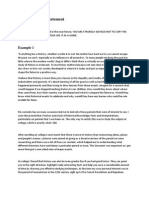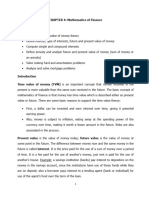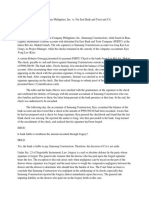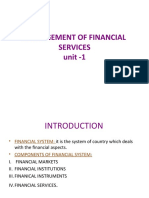Swaps Development of
Swaps Development of
Uploaded by
Bojan IvanovićCopyright:
Available Formats
Swaps Development of
Swaps Development of
Uploaded by
Bojan IvanovićOriginal Description:
Original Title
Copyright
Available Formats
Share this document
Did you find this document useful?
Is this content inappropriate?
Copyright:
Available Formats
Swaps Development of
Swaps Development of
Uploaded by
Bojan IvanovićCopyright:
Available Formats
Swaps market, development of
The development of swaps market has been tremendous from its creation in
the early 80s to its leader position in the derivatives market, with over 60
trillion dollars notional value of transaction for the year 2001 out of a total of
180 trillion dollars market (source BIS).
Although the first swap was a currency swap between the World Bank and
IBM, the swap market has been mainly driven by the fixed for floating interest
rate swaps market. Swaps are Over the Counter instruments involving the
exchange of one stream of payment liabilities for another.
The first swaps were motivated by the difficulty to exchange big sum of cash
between two currencies. In the early 80s, although the Bretton Woods
agreements had already collapsed and there were no official foreign
exchange controls (abolition in the US in 1973, and in 1979 for the UK), it was
still expensive for a company to exchange funds between two currencies.
In august 1981, IBM and the World Bank agreed to exchange the future
liabilities associated with borrowings in the Swiss Franc and the US Dollar
bond markets. This swap was to exploit the comparative advantage of the two
counterparties.
IBM enjoyed a very good reputation in Switzerland, perceived as one of the
US best name. In contrast, the World Bank suffered from a bad image since it
had used several times the Swiss market to finance risky third-world
countries. Consequently, the World Bank would have to pay an extra 20 basis
points compared to IBM.
At the same time, the World Bank, with an AAA rating, was a well established
credit name in the US and could get a lower financing rate (compared to IBM)
in the US Dollar bond market because of the backing of the US, German,
J apanese and other governments. It would have to pay the Treasury rate +40
basis points. It became very advantageous for IBM and the World Bank to
borrow in the market in which their comparative advantage was the greatest
and swap their respective fixed-rate funding obligation.
The swap market had a scarce existence before 1985. By the middle of the
80s, swaps transactions started to grow as issuers and investors could lower
their cost of financing or raise the yield on bond investments, by exploiting
comparative advantage and arbitrage via swap transaction.
Originally, banks and other financial institutions were merely acting as
middleman between the two counterparties of the swap, pocketing huge
commission. But gradually, as the swap market grew, banks and other
financial institutions started using swap to risk manage their interest rate and
currency exposure, using the flexibility of swaps, to transform fixed-interest
rate payment obligation into floating ones, or dollar denominated payment into
an other currency. Swaps up to the coming of the FAS 133, offered the
additional advantage to be off-balance sheet instruments and involved mostly
counterparties of high creditworthiness
Swaps have become popular because they can be used to transform either:
- a liability from one currency into another one, or from fixed to floating rate
or vice versa. For the exchange of floating rate in one currency versus a
floating rate in another currency, one refers to as a basis swap. For the
exchange of a fixed rate against a floating rate, one refers to as a vanilla
interest rate swaps, payer or receiver depending whether if we pay or
receive the fixed rate.
- or an asset paying fixed to floating or the opposite. In the case of a bond,
this is referred to as an asset swap.
The main argument that have been put forward to explain the spectacular
growth of the swaps market has been the comparative advantage arguments.
If basically says that different companies should take advantage from their
comparative advantage to borrow at a low rate (either at a fixed rate or a
floating rate). They should subsequently swap their financial obligation with a
companies that has just the opposite comparative advantage (can borrow
cheaper at a fixed rate than a floating rate for instance if the company could
borrow cheaper at a floating rate than a fixed rate).
A typical example would be the one of a weak credit name like a BBB
institution that would have to pay as much as 70 basis points extra compared
to an AAA-rated institution for a 5-year bond issue. In contrast, it would only
pay 30 basis points extra for a 5 year bank loan indexed on LIBOR. The
company would then be able to use the comparative advantage via a swap.
Suppose that the company were interested in borrowing at fixed rate. The
company would be better off by borrowing at a floating rate and swapping the
floating-rate obligation with a J apanese bank for a stream of fixed-rate interest
payments at a total cost of 50 basis points. The BBB company would save 20
basis point when using this synthetic 5-year fixed-rate loan.
The comparative advantage argument is still open to question as the spread
between the rates offer to companies are more a reflection of the market and
in particular the credit perception of the companies than anything else. A
comparative advantage at one point in time may dramatically change in the
case of a credit downgrade or upgrade.
Last but not least, the swap market has also developed tremendously in terms
of products offered, although the mainstream ones are still a fixed floating
interest rate swap. Financial engineers have also created various forms of
exotic swap like:
- forward swap starting in the future
- amortising swap: the notional reduces in a predetermined way
- CMS or CMT swap: one of the leg pays either a swap rate or a treasure
yield
- Quanto swap: the payment is done in another currency than the one in
which the swap is denominated
- Equity swap: the swap is between the dividend and capital gain realised
on an equity index and a floating (or fixed) leg
- Credit Default swaps: one pays a fixed spread to be protected against
certain credit event and in particular default of a specified bond.
Last but not least, with the growth of swap, the concern about the credit risk
involved in such transactions has been growing. However, there exists in the
credit derivatives market, swap that enables to swap the default risk against a
fixed payment. These are referred to as credit default swaps.
Figure 1: Summary of a fixed floating interest rate swap
Investor
Swap
Market
Maker
Fixed Rate
Floating Rate
Eric Benhamou
1
Swaps Strategy, London, FICC,
Goldman Sachs International
Entry category: swaps
Scope: reasons for innovation; nature of risks/problem; IBM-IBRD swap;
precursor structures; rationale: information, market impact, etc.
Related articles: Swaps types, taxonomy of; Swaps: interest rate swaps (IRS);
Swaps: cross-currency swaps (CCS); Commodity swaps; Equity swaps;
Complex swap structures
1
The views and opinions expressed herein are the ones of the authors and do not necessarily reflect
those of Goldman Sachs
You might also like
- Interest Rate Swaps and Other DerivativesDocument13 pagesInterest Rate Swaps and Other DerivativesColumbia University Press33% (9)
- Accounting and Finance Personal StatementDocument3 pagesAccounting and Finance Personal StatementBojan IvanovićNo ratings yet
- 2023 FRM Pii Pe2 020223Document158 pages2023 FRM Pii Pe2 020223lizzyli12062001No ratings yet
- Criminology Personal StatementDocument2 pagesCriminology Personal StatementBojan IvanovićNo ratings yet
- Business Personal StatementDocument2 pagesBusiness Personal StatementBojan Ivanović50% (2)
- Accounting Personal StatementDocument4 pagesAccounting Personal StatementBojan Ivanović50% (2)
- Aeronautical Engineering Personal StatementDocument2 pagesAeronautical Engineering Personal StatementBojan Ivanović50% (2)
- Civil Engineering Personal StatementDocument2 pagesCivil Engineering Personal StatementBojan Ivanović80% (10)
- Engineering Personal StatementDocument3 pagesEngineering Personal StatementBojan Ivanović100% (1)
- Biology Personal StatementDocument2 pagesBiology Personal StatementBojan Ivanović100% (2)
- Biomedical Science Personal Statement ExampleDocument1 pageBiomedical Science Personal Statement ExampleBojan Ivanović100% (6)
- Swaps NewDocument46 pagesSwaps NewJoseph Anbarasu100% (5)
- Fine Art Personal StatementDocument3 pagesFine Art Personal StatementBojan Ivanović100% (1)
- Chemistry Personal StatementDocument2 pagesChemistry Personal StatementBojan Ivanović100% (1)
- Internal Control Questionnaire For CashDocument4 pagesInternal Control Questionnaire For CashLeonidasNo ratings yet
- Risk Management Project SwapDocument28 pagesRisk Management Project Swaplucky137No ratings yet
- Swaps 1Document14 pagesSwaps 1Nilesh MandlikNo ratings yet
- An Introduction To SwapsDocument5 pagesAn Introduction To SwapsCh RajkamalNo ratings yet
- SwapDocument3 pagesSwapJohana ReyesNo ratings yet
- An Introduction To SwapsDocument4 pagesAn Introduction To Swaps777antonio777No ratings yet
- Swap (Finance) : Financial MarketsDocument9 pagesSwap (Finance) : Financial MarketsDakshesh RawatNo ratings yet
- Project On: Swaps-Structure, Irs and How To HedgingswapsDocument17 pagesProject On: Swaps-Structure, Irs and How To HedgingswapsanudonNo ratings yet
- Swaps ForexDocument6 pagesSwaps ForexNeeti KhanchandaniNo ratings yet
- Swaps Simple NotesDocument4 pagesSwaps Simple NotesAshwin RacerNo ratings yet
- DeepikaDocument31 pagesDeepikaPriyanka SharmaNo ratings yet
- Interest SwapsDocument6 pagesInterest SwapsamiNo ratings yet
- Interest Rate SwapsDocument11 pagesInterest Rate SwapsPuneet SrivastavNo ratings yet
- An Introduction To SwapsDocument12 pagesAn Introduction To SwapsdKritagyaNo ratings yet
- Notes F.D. Unit - 4Document15 pagesNotes F.D. Unit - 4kamya saxenaNo ratings yet
- Swaps - FinalDocument14 pagesSwaps - FinalsnehaNo ratings yet
- Interest Rate SwapsDocument19 pagesInterest Rate SwapsSubodh MayekarNo ratings yet
- FD Unit-VDocument9 pagesFD Unit-VDr.P. Siva RamakrishnaNo ratings yet
- Currency SwapsDocument6 pagesCurrency Swapspradeep3673No ratings yet
- Capital Market: Final ModuleDocument16 pagesCapital Market: Final ModuleEduardo VerdilloNo ratings yet
- Capital MarketDocument10 pagesCapital MarketEduar GranadaNo ratings yet
- Chapter 13 Currency and Interest Rate SwapsDocument24 pagesChapter 13 Currency and Interest Rate SwapsaS hausjNo ratings yet
- 2.2 - Swaps - NotesDocument10 pages2.2 - Swaps - NotesTGCNo ratings yet
- Currency SwapsDocument2 pagesCurrency SwapsMFOZOUNINo ratings yet
- Swaps by DR B Brahmaiah: Presentation OnDocument60 pagesSwaps by DR B Brahmaiah: Presentation Onbatx708100% (4)
- Financial Swaps EditedDocument19 pagesFinancial Swaps EditedMaria U DavidNo ratings yet
- Swaps Made Simple: What A Trustee Needs To KnowDocument19 pagesSwaps Made Simple: What A Trustee Needs To KnowPrabhakar SharmaNo ratings yet
- What Is A 'Currency Swap'Document11 pagesWhat Is A 'Currency Swap'Shubham PhophaliaNo ratings yet
- Shapiro Chapter Solutions ch09Document10 pagesShapiro Chapter Solutions ch09Kelvin ChenNo ratings yet
- SwapssDocument27 pagesSwapssaasifimamNo ratings yet
- SwapsDocument44 pagesSwapsAditya Paul SharmaNo ratings yet
- Swap Market: Source: BIS Semiannual Derivatives Statistics at End-December 2008Document4 pagesSwap Market: Source: BIS Semiannual Derivatives Statistics at End-December 2008studenthcNo ratings yet
- Demystifying Interest Rate SwapsDocument17 pagesDemystifying Interest Rate SwapsbionicturtleNo ratings yet
- Full Download of Foundations of Multinational Financial Management 6th Edition Shapiro Solutions Manual in PDF DOCX FormatDocument46 pagesFull Download of Foundations of Multinational Financial Management 6th Edition Shapiro Solutions Manual in PDF DOCX Formatkaplundatuga100% (2)
- Interest Rate Swaps Basics 1-08 USDocument6 pagesInterest Rate Swaps Basics 1-08 USbhagyashreeskNo ratings yet
- Unit III STUDENTDocument17 pagesUnit III STUDENTofficeidramanNo ratings yet
- Get Foundations of Multinational Financial Management 6th Edition Shapiro Solutions Manual Free All Chapters AvailableDocument46 pagesGet Foundations of Multinational Financial Management 6th Edition Shapiro Solutions Manual Free All Chapters Availablefokazitousif100% (1)
- Swap ContractsDocument11 pagesSwap ContractsSanya rajNo ratings yet
- Swap Risk Management ToolsDocument22 pagesSwap Risk Management ToolsMahveen KhurranaNo ratings yet
- Assignment On PC Colour BlackDocument10 pagesAssignment On PC Colour BlackMuhammadShoaibNo ratings yet
- Currency SwapsDocument3 pagesCurrency SwapsBalaram SahaNo ratings yet
- Libor Duffie Stein Jep 2015Document22 pagesLibor Duffie Stein Jep 2015petrepetre2014No ratings yet
- SWAPSDocument23 pagesSWAPSSidharth ChoudharyNo ratings yet
- Swap Chapter 1Document18 pagesSwap Chapter 1sudhakarhereNo ratings yet
- Fixed Income Markets (Overview)Document21 pagesFixed Income Markets (Overview)VishalMehrotraNo ratings yet
- SwapDocument87 pagesSwapsatawase50% (2)
- RMD Unit VDocument11 pagesRMD Unit Vjagan rathodNo ratings yet
- Chapter 10 Interest Rate & Currency Swaps Suggested Answers and Solutions To End-Of-Chapter Questions and ProblemsDocument15 pagesChapter 10 Interest Rate & Currency Swaps Suggested Answers and Solutions To End-Of-Chapter Questions and ProblemsAbdulrahman KhelefNo ratings yet
- 08 Zero Sum Game PDFDocument9 pages08 Zero Sum Game PDFAdnan KamalNo ratings yet
- Swap (Finance) : From Wikipedia, The Free EncyclopediaDocument6 pagesSwap (Finance) : From Wikipedia, The Free EncyclopediaLeo ChenNo ratings yet
- The Great Recession: The burst of the property bubble and the excesses of speculationFrom EverandThe Great Recession: The burst of the property bubble and the excesses of speculationNo ratings yet
- Fixed Income Securities: A Beginner's Guide to Understand, Invest and Evaluate Fixed Income Securities: Investment series, #2From EverandFixed Income Securities: A Beginner's Guide to Understand, Invest and Evaluate Fixed Income Securities: Investment series, #2No ratings yet
- The Securitization Markets Handbook: Structures and Dynamics of Mortgage- and Asset-backed SecuritiesFrom EverandThe Securitization Markets Handbook: Structures and Dynamics of Mortgage- and Asset-backed SecuritiesNo ratings yet
- Investing in Fixed Income Securities: Understanding the Bond MarketFrom EverandInvesting in Fixed Income Securities: Understanding the Bond MarketNo ratings yet
- FinTech Rising: Navigating the maze of US & EU regulationsFrom EverandFinTech Rising: Navigating the maze of US & EU regulationsRating: 5 out of 5 stars5/5 (1)
- History Personal StatementDocument3 pagesHistory Personal StatementBojan IvanovićNo ratings yet
- Geography Personal StatementDocument3 pagesGeography Personal StatementBojan Ivanović100% (1)
- Biomedical Science Personal StatementDocument1 pageBiomedical Science Personal StatementBojan Ivanović0% (2)
- Anthropology Personal StatementDocument2 pagesAnthropology Personal StatementBojan IvanovićNo ratings yet
- Actuarial Science Personal StatementDocument3 pagesActuarial Science Personal StatementBojan Ivanović100% (1)
- Sep Inox 8 DubinskeDocument10 pagesSep Inox 8 DubinskeBojan IvanovićNo ratings yet
- 2interview QuestionsDocument26 pages2interview QuestionsBojan IvanovićNo ratings yet
- Poland 2013Document28 pagesPoland 2013Bojan IvanovićNo ratings yet
- FM Researchstat 2013 A1 enDocument12 pagesFM Researchstat 2013 A1 enBojan IvanovićNo ratings yet
- Triennial Survey On The Foreign Exchange and Derivatives Markets: Results For BelgiumDocument11 pagesTriennial Survey On The Foreign Exchange and Derivatives Markets: Results For BelgiumBojan IvanovićNo ratings yet
- Trien Surv Stat AnnexDocument23 pagesTrien Surv Stat AnnexBojan IvanovićNo ratings yet
- Exchange Arrangements and Exchange Restrictions: Annual ReportDocument106 pagesExchange Arrangements and Exchange Restrictions: Annual ReportBojan IvanovićNo ratings yet
- ConfirmationDocument2 pagesConfirmationAmutha AmmuNo ratings yet
- Ch.4 Math of Finance-1Document19 pagesCh.4 Math of Finance-1hildamezmur9No ratings yet
- Short - DigitalPowerHoldings - RousselDocument11 pagesShort - DigitalPowerHoldings - RousselMichael RousselNo ratings yet
- M. Samsung Construction Vs Far East BankDocument2 pagesM. Samsung Construction Vs Far East BankPaulitoPunongbayanNo ratings yet
- Chapter 20 PDFDocument27 pagesChapter 20 PDFPushp DhingraNo ratings yet
- Ultimate Shortcut Trick To Remember Bank Headquarters in India Bankers AmbitionDocument8 pagesUltimate Shortcut Trick To Remember Bank Headquarters in India Bankers AmbitionSahil GuptaNo ratings yet
- Liberty Newspost Feb-03-10Document77 pagesLiberty Newspost Feb-03-10Liberty Newspost Corp.No ratings yet
- Abl LoanDocument6 pagesAbl LoanMehro MughalNo ratings yet
- 190226155747MHADA Nashik Booklet 2019 PDFDocument90 pages190226155747MHADA Nashik Booklet 2019 PDFChaitanya M MundheNo ratings yet
- Statement Dec 23 XXXXXXXX9150Document18 pagesStatement Dec 23 XXXXXXXX9150bsvz89m56pNo ratings yet
- Repo and Reverse Repo RateDocument8 pagesRepo and Reverse Repo RateJinujith MohanNo ratings yet
- OOAD Short NotesDocument13 pagesOOAD Short NotesShan PathirajaNo ratings yet
- TransNum Mar 11 121407 PDFDocument4 pagesTransNum Mar 11 121407 PDFஇரா. சந்திரசேகர்.No ratings yet
- MANAGEMENT OF FINANCIAL SERVICES Unit 1Document35 pagesMANAGEMENT OF FINANCIAL SERVICES Unit 1Goutham Singh0% (1)
- DRKW Rate StructuringDocument20 pagesDRKW Rate StructuringLisa SmithNo ratings yet
- Welcome Letter Password HARS060479Document5 pagesWelcome Letter Password HARS060479jalajhbhattNo ratings yet
- Canadian Payment Systems PowerpointDocument11 pagesCanadian Payment Systems PowerpointPrinting CommitteeNo ratings yet
- Prospects and Problem Women Entrepreneurship in BangladeshDocument13 pagesProspects and Problem Women Entrepreneurship in BangladeshTarequl IslamNo ratings yet
- Finance - MoneyDocument4 pagesFinance - MoneyMS CSNo ratings yet
- Commercial Bank ManagementDocument8 pagesCommercial Bank ManagementShilpika ShettyNo ratings yet
- Markets and Commodity Figures: Total Market Turnover StatisticsDocument6 pagesMarkets and Commodity Figures: Total Market Turnover StatisticsTiso Blackstar GroupNo ratings yet
- Account Statement: Dhamodharan K S/O Kannan 174/1 Boyar Street Eliyathur Thengiyanatham Post ChinnasalemDocument65 pagesAccount Statement: Dhamodharan K S/O Kannan 174/1 Boyar Street Eliyathur Thengiyanatham Post ChinnasalemHari HaranNo ratings yet
- 10 Ideas For Economic Development, 2013Document32 pages10 Ideas For Economic Development, 2013Roosevelt Campus NetworkNo ratings yet
- Capital Investment Appraisal in Retail Business Management: Sainsbury's As A Case StudyDocument6 pagesCapital Investment Appraisal in Retail Business Management: Sainsbury's As A Case StudyIOSRjournalNo ratings yet
- Cash ManagementDocument3 pagesCash ManagementPoorna Chandra GaralapatiNo ratings yet
- Internship Report 2019 Bop KarorDocument25 pagesInternship Report 2019 Bop KarorArham khanNo ratings yet
- Money PadDocument17 pagesMoney PadPrajoth PaiNo ratings yet
- Internet Customer Acquisition at Bankinter: Class Discussion QuestionsDocument1 pageInternet Customer Acquisition at Bankinter: Class Discussion QuestionsDushyant PandaNo ratings yet


















